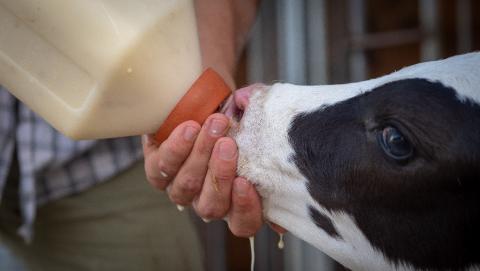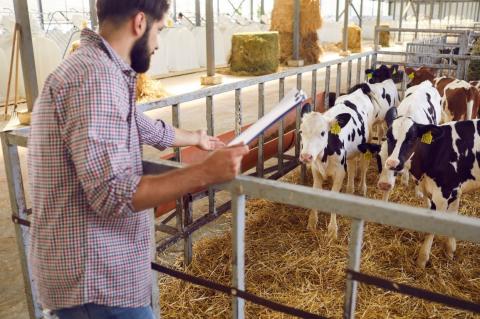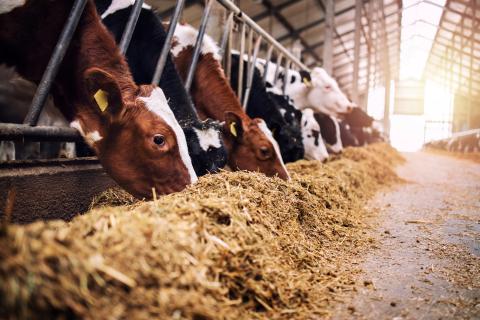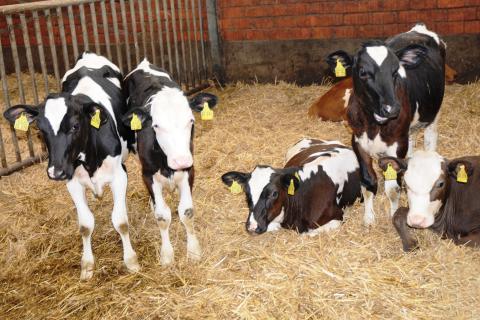13 April 2022
Nia Davies: IBERS, Aberystwyth University.
- The standard of pre-weaning nutrition can have long term effects on the performance of calves
- Feeding either milk replacer or whole milk comes with a variety of considerations
- Do not forget that calves require access to clean and fresh water
- Meeting the nutritional requirements of calves will help improve efficiency and sustainability
The 3 Q’s – Quantity, Quality and Quickly
It is well known that colostrum is essential for new-born calves. Mainly because calves are born with virtually no immunity, and they acquire this from the dam. Therefore, it is vital that calves receive the correct quantity of high IgG1 colostrum within the first few hours of life to ensure optimal passive transfer. The failure of passive transfer immunity can result in increased calf morbidity and mortality. There are several factors to consider when thinking about colostrum management and what can be done to ensure calves are gaining passive immunity. Further reading on this can be found in a previous article written by Dr Cate Williams. This article will mostly focus on the post colostrum phase.
Milk replacer or whole milk
The majority of dairy farms are feeding colostrum milk for a minimum period of 3 days and studies have shown benefits with prolonged feeding of the dam’s milk in terms of health and growth rates. For reasons such as cost, farm/feeding system or breed of calf, dairy farms are faced with the decision of feeding either whole milk or milk replacer.
Often calves are provided with 10% of their calf birth weight in milk, approximately 4-5 litres daily, between 7 and 56 days old. Which is, in fact, less than half of what they would consume if fed ad libitum via an automated system. The traditionally lower feed rate is often related to cost and to encourage calves to increase their intake from concentrates or forage to aid rumen development. Also, producers may feel calves experience a degree of nutritional scours, as some studies have found, when feeding a significantly higher rate of milk powder, as such this is avoided. However, for calves to achieve a growth rate greater than 700g/day feeding of a greater quantity of milk replacer may be necessary, depending on a dairy farms’ current feed rate.
Additionally, increasing the nutrient intake, in up to 56 days old calves, from milk has been shown to increase initial milk yield during the subsequent first lactation. Feeding 8 litres/per calf daily, of milk replacer, has been shown to increase weaning body weight compared to feeding 6 litres and interestingly although calves on the lower feed rate consumed a marked increase in starter feed they did not grow faster. Increasing the volume of milk also depends on the water: powder (g) ratio. Following a high-solids milk feeding strategy can improve calf growth rate in the pre weaning stage by providing a greater amount of nutrients to support growth and skeletal development.
Typically, within the first week calves are fed 600g of powder per day and this is increased to 1kg by week three. Some factors to take into consideration with milk replacer feed rates are climatic conditions, particularly temperature. When temperatures drop below 10°C calves may require additional energy to meet the increase in maintenance energy requirements to generate heat. It is important to carefully read the instructions provided with milk powder bags and follow best advice on feed rate in conjunction with your farm nutritionist or vet.
An important factor to consider when deciding on milk replacer or whole milk is the quality and composition of each. Whole milk is generally a more consistent product and depending on the breed of cows is often high in protein and fat, naturally. With several different milk replacers commercially available, it can be challenging to find one which is both high in quality and reasonable in price. Calf milk replacers usually contain higher levels of lactose and lower levels of fat than whole milk, with a crude protein content ranging from 20 to 28%. Milk replacer is often supplemented with other
materials such as vitamins, minerals and enzymes which promote animal health and support the digestion and absorption of nutrients. If you’re feeding whole milk to calves, vitamin and mineral deficiencies is something to consider, particularly vitamin A and E as they’re antioxidants and help promote good health. Along with all these factors for consideration, consistency is key, especially in young animals. A feeding protocol that outlines correct mixing instructions is very important in achieving the best results from your milk replacer in particular.
Concentrates, fibre and water
Concentrate starter feed needs to be readily available to calves within the first few days of life. It is crucial that calves are not restricted from concentrates during the milk feeding phase. The calf’s metabolism and tissues will change from relying on glucose supplied by milk to metabolising short chain fatty acids as the primary energy source. Solid feed will stimulate rumen development, particularly due to volatile fatty acids as they support rumen papillae development. This will increase the surface area of the rumen that’s available for nutrient absorption, which is fundamental in achieving good health and growth rates. The source and quantity of starch in the starter feed is an important consideration as it will be the main source of volatile fatty acids. Adequate protein content is also important as it optimizes ruminal fermentation, often starter feeds contain 18% crude protein, although this percentage along with starch will depend on overall nutrients supplied within the diet. As previously mentioned, it is important to work with a farm nutritionist or vet to determine a balanced diet.
In addition to concentrates, dietary fibre should be provided to calves to encourage and maintain abrasion in their rumen and promote muscular development of the rumen. The most common sources of fibre are hay and barley or wheat straw. Particle size of fibre is often debated, longer particle size has been shown to result in higher rumen pH, possibly due to increased time spent chewing, increasing saliva production. Whereas finely ground diets may result in a decreased rumen pH. Calves will usually acquire digestive cellulolytic activity when they are 3-4 weeks of age, therefore, providing a source of fibre before that time will be beneficial. Water is also an integral part of the calf’s diet. Calves are usually fed restricted amounts of milk at certain times a day, unless they’re on an ad libitum feeding system.
Therefore, providing clean and fresh water is vital for calves to remain hydrated and is an animal welfare requirement. Water intake is also positively correlated by increased body weight in dairy calves, due to an increase in dry matter intake.
Summary
To conclude, calves receiving the correct level of nutrition, particularly during the first 8 weeks of life have been shown to have an increase in live weight gain and a reduction in disease occurrences. Ensuring nutrient intake that calves receive during the pre-weaning stage is sufficient has also been shown to positively correlate with the milk yield during first lactation. There are a number of factors to consider when choosing to feed milk replacer or whole milk, along with the type and composition of concentrates and the source of fibre fed to calves. The farm system and management may also be a deciding factor. Ultimately, meeting the nutritional requirements of calves is crucial in terms of efficiency and sustainability.
If you would like a PDF version of the article, please contact heledd.george@menterabusnes.co.uk




